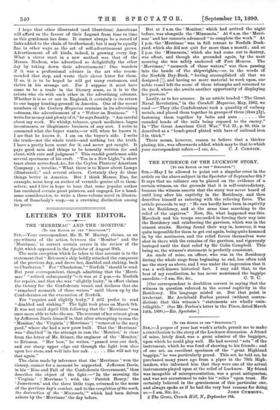THE EVIDENCE OF 111.M LUCKNOW STORY.
[TO THE EDITOR OF THE " BFECTATOR."]
SIR,—May I be allowed to point out a singular error in the article on the above subject in the Spectator of September 6th It says that no reliance can be placed on the evidence of a certain witness, on the grounds that it is self-contradictory„ because the witness asserts that the story was never heard of until long after his captivity in the Residency, and then describes himself as entering with the relieving force. The article proceeds to say : " He can hardly have been in captivity in the Residency, and at the same time marching to the relief of the captives." Now, Sir, what happened was this. Havelock and his troops succeeded in forcing their way into. the Residency and reinforcing the garrison, which was in the utmost straits. Having found their way in, however, it was quite impossible for them to get out again, being quite hemmed in by the mutineers, and the relief forces themselves were shut in there with the remains of the garrison, and rigorously besieged until the final relief by Sir Colin Campbell. This being so, the witness's statement is perfectly consistent.
An uncle of mine, an officer, who was in the Residency during the whole siege from beginning to end, has often told me the story as above, and I was under the impression that it was a well-known historical fact. I may add that, to the best of my recollection, he has never mentioned the bagpipe [Our correspondent is doubtless correct in saying that the witness in question referred to the second captivity in the Residency. His language misled us. But that point is irrelevant. Mr. Archibald Forbes proved (without contra- diction) that this witness's " statements are wholly unin- telligible." (See Mr. Forbes's letter in the Times, dated March 14th, 1890.)—En. Spectator.]






































 Previous page
Previous page